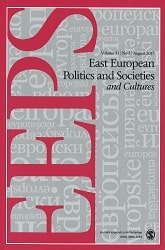Enacting Identities in the EU–Russia Borderland An Ethnography of Place and Public Monuments
Enacting Identities in the EU–Russia Borderland An Ethnography of Place and Public Monuments
Author(s): David J. Smith, Stuart BurchSubject(s): Political history, Government/Political systems, Cultural Anthropology / Ethnology, Nationalism Studies, Transformation Period (1990 - 2010), Post-Communist Transformation, Sociology of Politics, Politics and Identity
Published by: SAGE Publications Ltd
Keywords: identity; Estonia; monuments; nationalism; Narva; place; heritage; photoelicitation;
Summary/Abstract: Drawing on Rogers Brubaker’s theoretical analyses of “nationness” and nationalism in post-communist Europe, this article examines the dynamics of social identity within the nationally contested setting of the Estonian–Russian borderland. Since 1991, the city of Narva (96% Russophone by population) has customarily been defined (both politically and academically) in binary national terms as a “Russian enclave” within a unitary and “nationalizing” Estonian state. An ethnographic approach to the case, however, gives a rather different perspective, pointing to hybridity rather than nationality as the defining characteristic of identity politics within the city. In what follows, we bring to bear the results of extensive fieldwork carried out in Narva during 2006–2008. We first examine how different identity categories (local, national, meso-regional, and supranational) are being officially inscribed within Narva’s sites of memory. Thereafter, we focus on how these discursive-material articulations of place are implicated within the everyday performance of identity amongst the city’s population. Using the novel methodology of photo elicitation, we examine how residents of Narva appropriate but also subvert the identity categories that elites and outsiders (including ourselves as researchers) would seek to impose on them from above. This study (we argue) is significant for its methodological novelty, as well as in terms of giving a more nuanced understanding of Narva’s situation at a time of continued ethnopolitical contestation within Estonia as a whole.
Journal: East European Politics and Societies
- Issue Year: 26/2012
- Issue No: 02
- Page Range: 400-424
- Page Count: 25
- Language: English
- Content File-PDF

